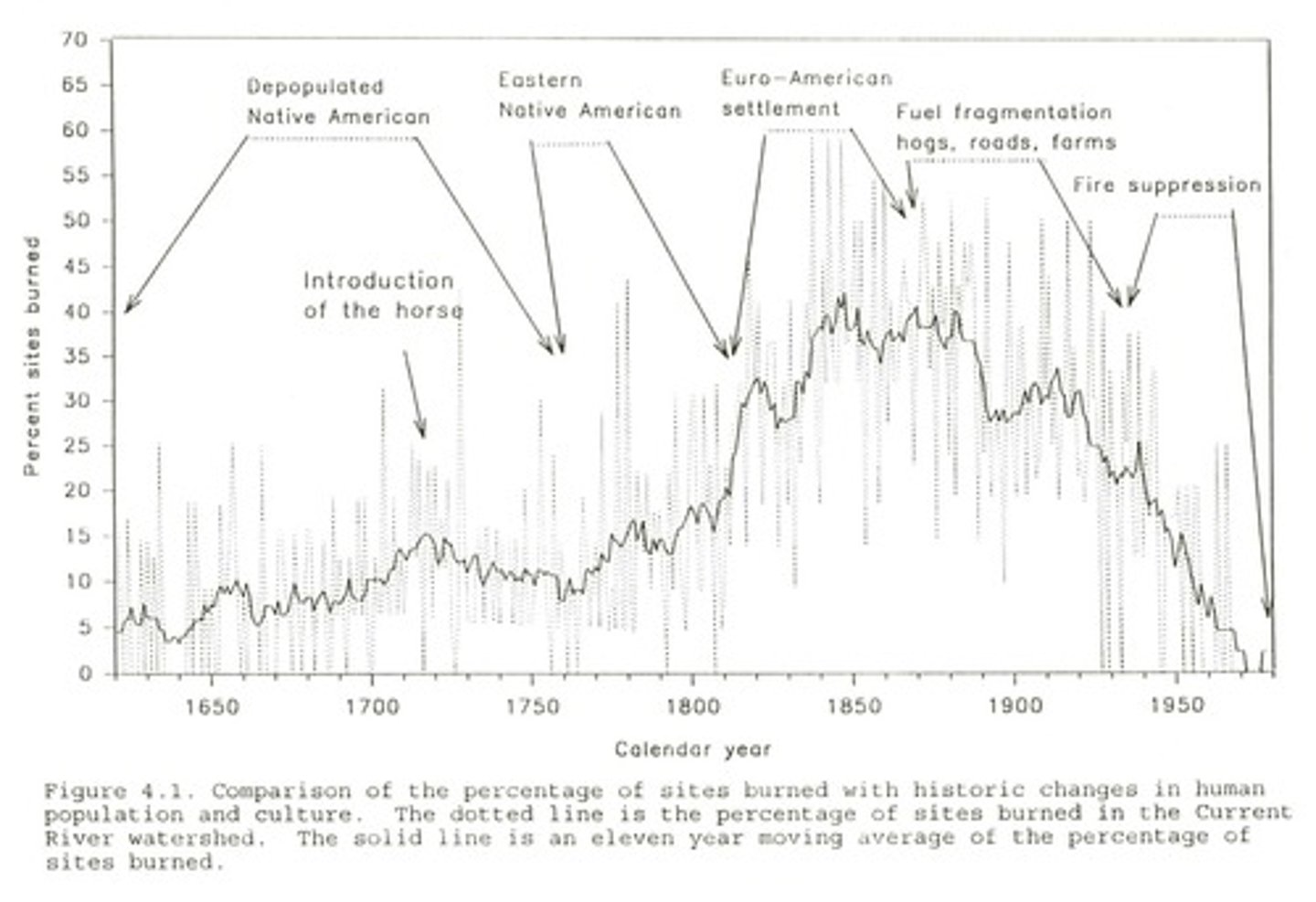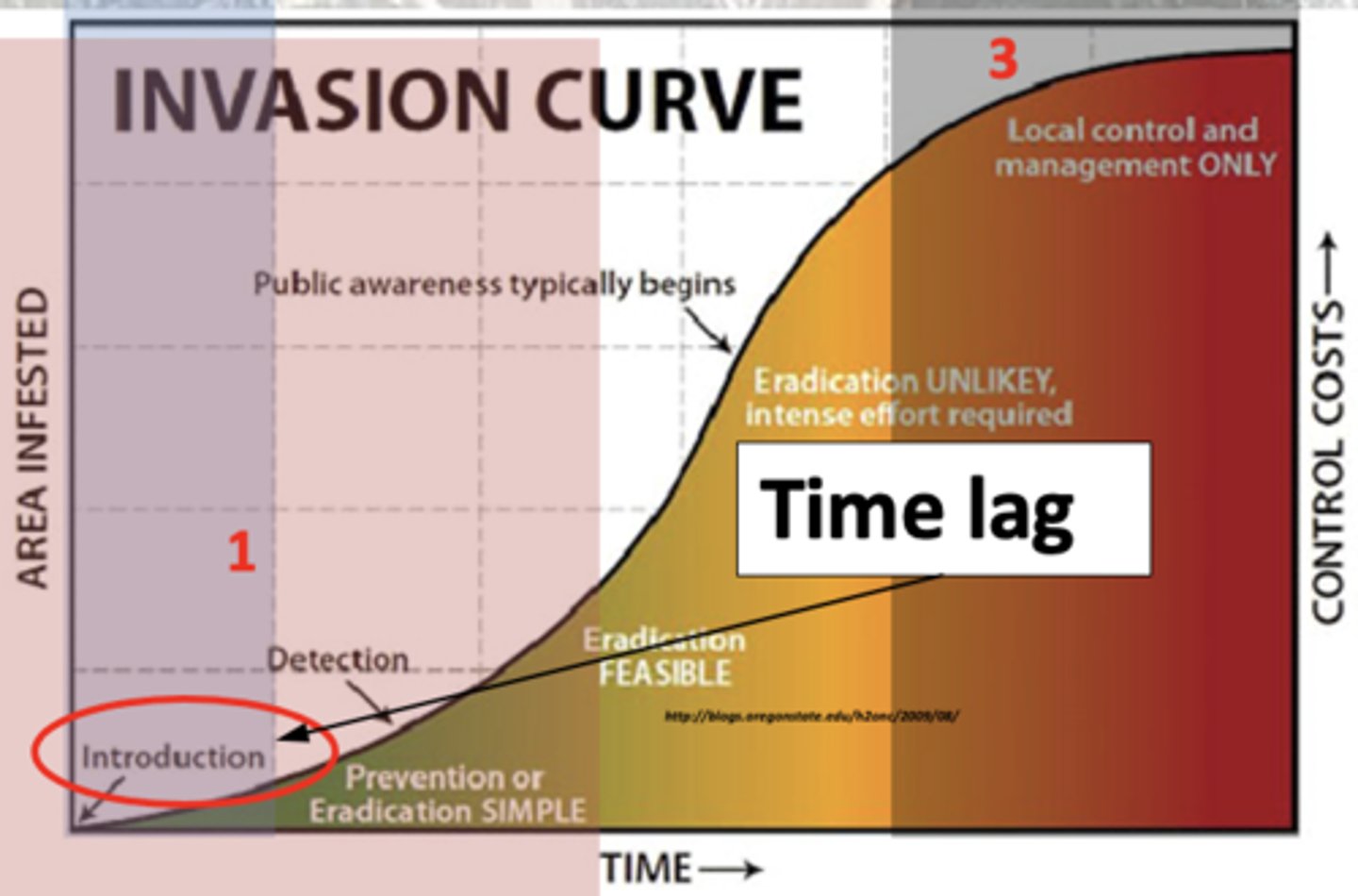FNR 331 Quiz 4
1/77
There's no tags or description
Looks like no tags are added yet.
Name | Mastery | Learn | Test | Matching | Spaced |
|---|
No study sessions yet.
78 Terms
move out onto the savanna and perpetuate it during migration
The use of fire allowed early man to
Come back to this
Come back to this

Forest Reserve Act of 1891
The _______ allowed presidents to set aside forestland, but was amended to stop President TDR from setting aside more public land.
Antiquities Act of 1906; 18
The ______ was designed to protect historic and paleontological sites from looting. President TDR used it to set aside ___ national monuments.
Rangers under the wing of Gifford Pinchot who worked underpaid (or unpaid) for the new National Forest System
Who were Teddy's Green Rangers or Little GP's?
The Big Burn of 1910
-three million acres burned in NE Washington, N Idaho, and W Montana over two days
-killed 87 people
What was the largest fire recorded in US history?
suppression
The Big Burn led to a shift to what fire paradigm?
-acquisition of land at the head of navigable streams as national forests
-cooperative agreements and matching funds between the USFS and state foresters to provide fire protection on similar lands
What did the Weeks Act (1911) allow for?
-authorized purchase of lands needed for the production of timber
-agreements with the states for the protection of state-owned and private lands against fire
-assured the cooperative relationships between federal and nonfederal programs formalized by the Weeks Law would be retained
What did the Clarke-McNary Act (1924) do?
steam donkeys -> steam-driven hoist used in logging, mining, and maritime use that threw sparks
What were the main causes of anthropogenic fire?
False
True or false: spruce-fire forests are tolerant and adapted to fire
Southerns commonly used fire to manage the landscape (I.e., "You go the money, but we got the time. You cut the hardwoods, and we'll burn the pine")
What was the attitude towards fire in the south?
public education with the intention of making traditional fire practices unacceptable
Early fire prevention efforts were focused on:
-500,000 young men working for fire suppression efforts
-provided the workforce of active fire suppression
-fought fire, built fire towers and roads
What was the Civilian Conservation Corp (CCC), and what did they do?
World War II
-huge increase in industrial output required by the war effort made lumber and wood products an even more important commodity
What intensified how wildland fire was viewed? Why?
dry; wet
Fire intensity regimes are dependent on how ___ and ____ an area is.
more often; favor ignition; low intensity fires
Warm dry areas burn ____ because conditions frequently ___. What type of fire does this lead to?
less often; ignition; buildup of fuels leads to high severity and high intensity fires.
Cool mesic areas burn ____, but when condition are right for ____, what happens?
Oak woodlands, ponderosa pine, mixed conifer, most Eastern examples
Give examples of low intensity regimes.
Yellowstone fires; subalpine forests
Give example of high intensity fire regime.
No; 30 years of suppression probably did not have a dramatic effect on its multi-century fire return interval
Where the Yellowstone Fires a product of fire suppression?
organisms that are not native to a particular geographic area
What are non-native species?
True
True or false: Some species expand their ranges into new area 'naturally' and are NOT considered non-native
result of anthropogenic changes to the landscape
Why do some species move into new areas?
"an alien species whose introduction does or is likely to cause economic, environmental, or human health harm"
-harm is a human value judgment that is sometimes difficult to quantify and can be a point of contention with invasive species
What is an invasive species?
-Sea lamprey
-Garlic mustard (1868):
-Gypsy moth (1868):
-Chestnut blight (1905):
-Hemlock Wooly Adelgid (1924):
-Emerald Ash Borer (2002)
-Amur honeysuckle (1897)
Give some examples of invasive species:
on purpose; on accident
Typically, invasive plants are introduced ____ while insects are introduced ____.
Amur honeysuckle
Nield E. Hansen brought back ____ in what year?
1) short generation time
2) high growth rates
3) rapid dispersal mechanisms with numerous prpagules
4) strong competitors
5) able to tolerate a broad range of environmental conditions
What makes a good invader?
1) enemy release
2) evolution of increased competitive ability (EICA)
3) possession of 'novel weapons'
4) pre-adaptation/innate weediness
What makes invasive species from native species?
For every 1000 species you introduce, only 10% establish (100), 10% naturalize (10), and 10% become invasive (1)
Describe the ten's rule.
introduced habitat is suitable and species is able to reproduce
What does establishment mean?
introduced species is able to disperse
What does naturalize mean?
Enemy release (come back)
come back
Give examples of species that became invasive via enemy release.
-because of a lack of native herbivores, introduced plants reallocate resources from defense to growth and development mechanisms
-evolve to grow taller, produce more biomass, and yield more viable offspring than their native counterparts
Describe how the evolution of increased competitive ability hypothesis works:
Lag period
______ typically occurs between when an invasive species is introduced and when it becomes invasive
more aggressive
Invasive plants appear to be ______ in their introduced ranged compared to their native range
1) Time is needed for adaptive evolution
2) Intentional and multiple introductions create satellite populations and promote genetic diversity of the invasive speciees
3) For some species, time is needed to build up enough sexually mature individuals to expand the population (local scale)
Why is there lag?
1 = establishment phase
2 = expansion phase
3 = saturation phase
Label 1, 2, and 3 on the invasion curve.

adaptive evolution; genetic
_____ is required to overcome ____ constraints to successful invasion.
Multiple introduction
-gypsy moth thought to originate from a single invasion, but actually E. maimaiga introduction in 1911 pushed back the invasion front until mid-late 1990s
____ may be required for species that are not genetically diverse to reintroduce. Give an example.
novel weapon (I.e., trait) giving advantage over native plants
-allelopathic -> Tree of Heaven and garlic mustard
-spotted knotweed -> produced more chemicals in introduced range compared to native range that suppresses competitors
What are novel weapons? Give examples.
-longer growing season
-holds onto leaves longer
Give examples of pre-adaption/innate weediness traits that allow some species to become invasive.
-plants evolved during Pleistocene Glaciation are used to climates caused by glaciation -> holds onto chlorophyll makes them pre-adapted to succeed
Why do some species have pre-adaption/innate weediness?
Oriental bittersweet hybridizing with American bittersweet. -> they cross and American bittersweet is rare
Describe some dangers of relatedness.
rare species replaced by hybrids
What is genetic swamping?
wasteful production of maladaptive hybrids
What is demographic swamping?
1) time of year/season of burn
2) ecosystem type
3) intensity of the fire (heat generated/area/time)
4) fire frequency
5) fire type (crown vs surface vs ground)
Actual effects of fire are variable and depend upon:
-greater effect on vegetation
-plants are biologically active
Growing season burns have what type of effect? Why?
more intense
Late growing season (summer) burns favor what type of fires?
-fuel loading
-fuel type
-environmental conditions
Fire intensity varies with:
flame length
____ is an indicator of fire intensity.
-the impacts of fire on vegetation and the physical site
-measured by changes in density, reduction in duff, char severity, mortality, etc.
What is fire severity? How is it measured?
community type
Fire frequency varies with ____.
Fuel condition; local climate
_____ and ____ determine how frequently a particular ecosystem will burn.
inversely
Frequency is _____ to intensity/severity.
-Annual burns: herbaceous layer diverse w/ mixture of grasses and forbs and w/o woody reproduction layer
-5 year burns: resprouts presents but dead because fires came through during vulnerable stage; recruitment occurs because fire does not burn evenly
-No fire: ingrowth of shade tolerant shrub and tree species
Describe how fire frequency might influence a vegetation community.
mosaic
Fire burns unevenly which creates a ____.
leaf litter (leaves duff and humus)
Most burns in Central Hardwood forests only remove the ____.
intensely; quickly
Prairie burns ____ relative to local forests, but the fire moves ____.
much more severe; growing season
Burns in pine forests can be _____, especially if they occur during the _____.
1) surface -> leaf litter and small stems
2) ground fires -> fire burns into the ground
3) crown fires
What are the types of fire?
drier organic soils; low; high (rhizomes, roots, herbs)
Ground fires occur with more _____ soils. They are ____ intensity and ____ severity.
1) Passive -> individual crows igniting (can occur during ground and surface fires (I.e., candling)
2) Active -> fire spreads through crown (surface, ground, and crown advancing together)
3) Independent -> fire in canopy and environmental conditions allow the fire to spread independently into the crown
What are the types of crown fires?
1) Rapid decomposer of organic matter
-release of nutrients
-increase soil pH
-CO2 released into air
2) Change in forest structure and composition
What are the two major effects of fire?
changing forest structure; greater
Most objectives of prescribed fire relate to ______, with repeated burning having ____ effect on composition.
1) overstory mortality
2) understory mortality
3) litter and duff reduction
Fire causes what types of structural changes?
-hardwoods gone
-table mountain pine stand regenerating
-opened overstory and reduced understory litter/duff
What effects did the Chimney 2 Fire have?
flush of nutrient; herbaceous-layer
Surface fires in hardwood forests create a ____ that can flush growth in _____ vegetation.
dormant seasons (spring and fall)
While some herbaceous species reinvade slowly after fires (slow dispersal via ants), forest herbs readily survive surface fires that occur during ____.
True
True or false: smoke from fires can have a natural anti fungal effect
fire against the prevailing wind direction
What is a backing fire?
-easiest and safest
-produces minimum scorch
-time consuming
-requires a steady wind and low fuel moisture (<20%)
What are backing fires used for?
baseline secured with a backing fire, then wind blows through fire
What is a strip head fire?
-good method for hardwood standard
-relatively quick
-can be used in relatively high humidity (50-60%) and fuel moisture (20-25%)
-potential for top scorch
Why are strip head fires used?
-ping pong balls filled with napalm are dropped from helicopters
-topography and non-fire print vegetation types are used as fire breaks
-back fires used to secure fire lines along trails and roads
How do landscape-level fires work?
true mosaic
Landscape-level burns create a _____ of burn severities.